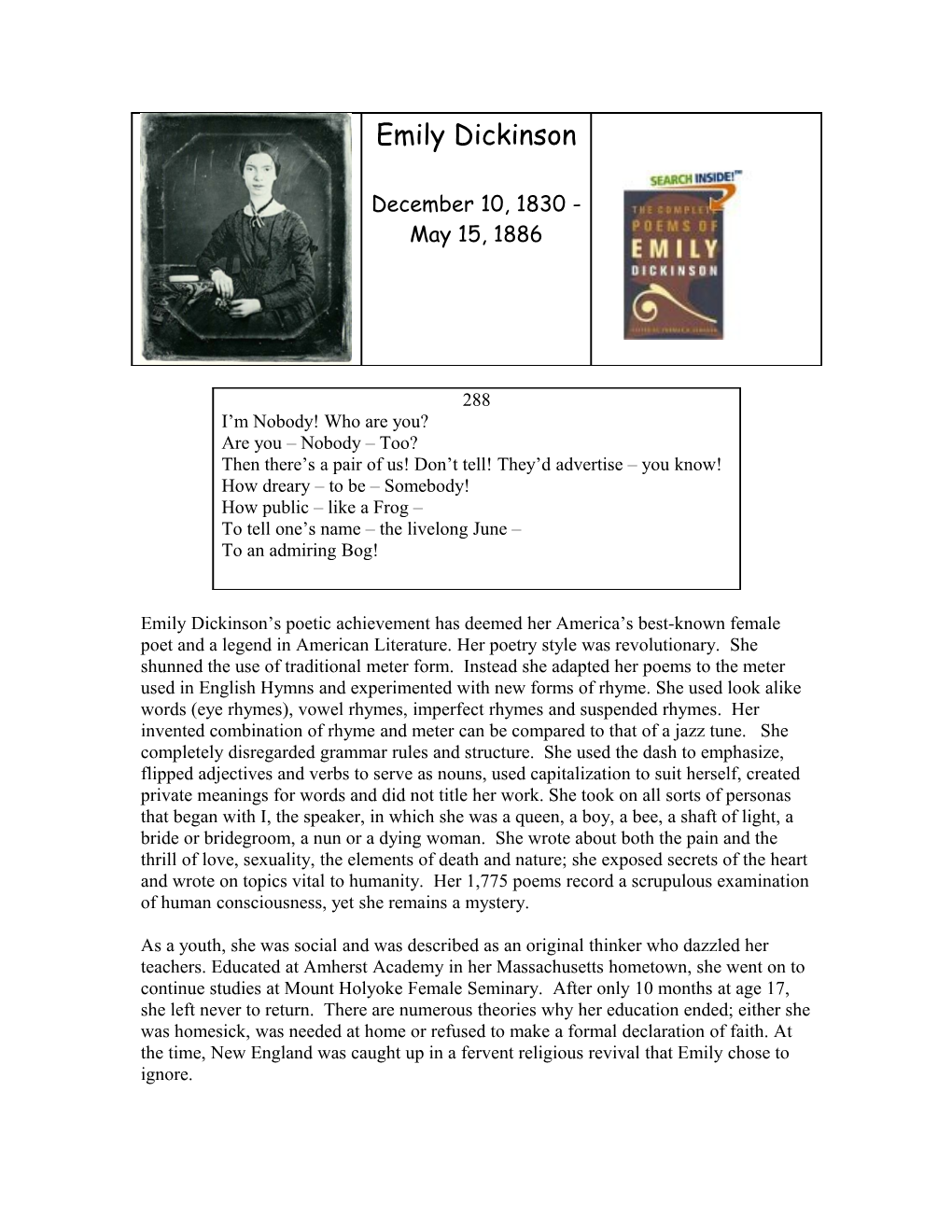December 10, 1830 -May 15, 1886 /
288
I’m Nobody! Who are you?
Are you – Nobody – Too?
Then there’s a pair of us! Don’t tell! They’d advertise – you know!
How dreary – to be – Somebody!
How public – like a Frog –
To tell one’s name – the livelong June –
To an admiring Bog!
Emily Dickinson’s poetic achievement has deemed her America’s best-known female poet and a legend in American Literature. Her poetry style was revolutionary. She shunned the use of traditional meter form. Instead she adapted her poemsto the meter used in English Hymns and experimented with new forms of rhyme.She used look alike words (eye rhymes), vowel rhymes, imperfect rhymes andsuspended rhymes. Her invented combination ofrhyme and meter can be compared to that of a jazz tune. She completely disregardedgrammar rules and structure. She used the dash to emphasize, flipped adjectives and verbs to serve as nouns, used capitalization to suit herself, created private meanings for words and did not title her work. She took on all sorts of personas that began with I, the speaker, in which she was a queen, a boy, a bee, a shaft of light, a bride or bridegroom, a nunor a dying woman. She wrote about both the pain and the thrill of love, sexuality, the elements of death and nature; she exposed secrets of the heart and wrote on topics vital to humanity. Her 1,775 poems record a scrupulous examination of human consciousness, yet she remains a mystery.
As a youth, she was social and was described as an original thinker who dazzled her teachers. Educated at AmherstAcademy in her Massachusetts hometown, she went on to continue studies at Mount Holyoke Female Seminary. After only 10 months at age 17, she left never to return. There are numerous theories why her education ended; either she was homesick, was needed at home or refused to make a formal declaration of faith. At the time, New England was caught up in a fervent religious revival that Emily chose to ignore.
Later on, she began to withdraw from public society.She shared the family homestead with her sister Lavinia, and their brother Austin and his family lived in the house next door. By the time Emily was in her 30s, she never left home anddressed only in white.She wrote in the secrecy of her room which afforded views of hayfields, mountains and the town beyond. During the day she jotted words and lines on butcher paper, old grocery lists or whatever scraps were available about the house and tucked them in her pocket. Once in the privacy of her room, she honed the words to perfection. She had the ability to take an experience, an emotion, a moment or a vision and pare it down to the barest particle so pure, it was just an essence waiting to escape the page. Thereader need only breathe it in. Or she could conjure up words that create fear so real, the reader experiences what Dickinsondescribed as a “zero at the bone” (# 986The Narrow Fellow in the Grass). She could vividly convey suffering and anguish (see poems # 599 There is a pain –so utter; #937 I felt a Cleaving in my Mind; and# 410 the first Day’s night had come). Without leaving her home or garden for years on end, she was gifted with an ability to make readers reexamine the world from various perspectives. She found inspiration in her garden and created a social structure for the flowers, birds and insects. Although a recluse, she veraciously wrote letters to friends and often enclosed hand sewn little booklets of selected poems as gifts. She had a long correspondence with Thomas Wentworth Higginson, an important19th Century poet, essayist and writer. It began when Higginson advised and challenged young writers in an article he wrote for the Atlantic Monthly. Dickinson took up the challenge and wrote him a letter. She enclosed four poems and asked, “Are you too deeply occupied to say if my Verse is alive?" He both admired her work and criticized her unconventional style. She was defiant though and continued inventingand exploring beyond the boundaries of her craft.
She had only 10 poems published during her lifetime and intentionally chose not to publish. She died at home on May 15, 1886 at age 55. After her death, her sister Lavinia found the stitched packets of poems stashed in a drawer. Despite a close sibling relationship, Lavinia was stunned by the genius and prolific quantity of poems Emily left behind. With the help of Higginson and neighbor Mabel Loomas Todd, the poems were published. Dickinson became an overnight sensation. More than a century later, Emily Dickinson stands out as one of American Literature’s most influential poets.
Further reading: The complete Poems of Emily Dickinson (Edited by Thomas H. Johnson). In this volume, Dickinson’s poems are returned to their original unedited form and sequence.
Two of my favorite children’s picks are: Emily Dickinson's Letters to the World by Jeanette WinterandThe Mouse of Amherstby Elizabeth Spires and Claire A. Nivola.
Visit the EmilyDickinsonMuseum and homestead at:
